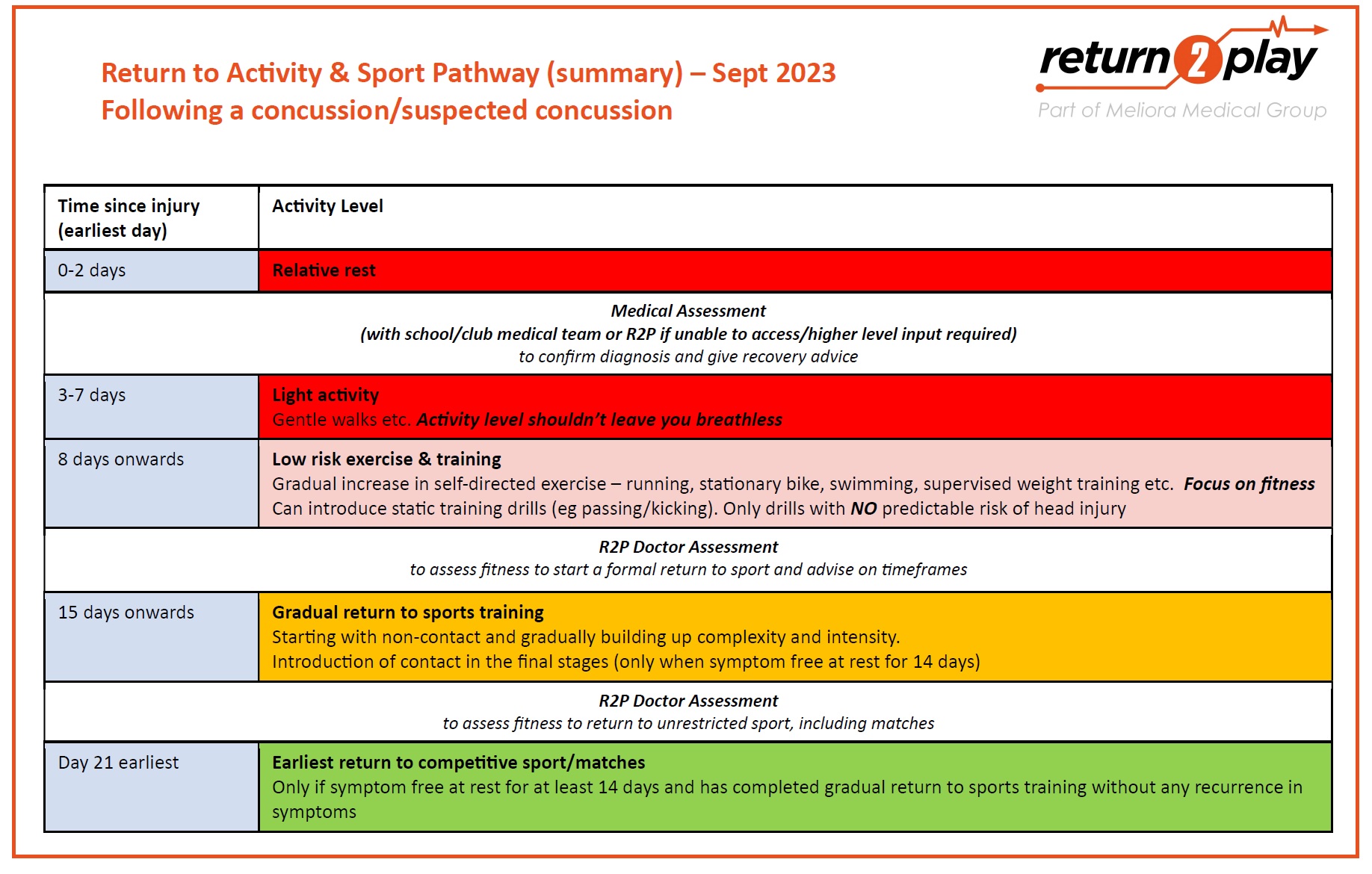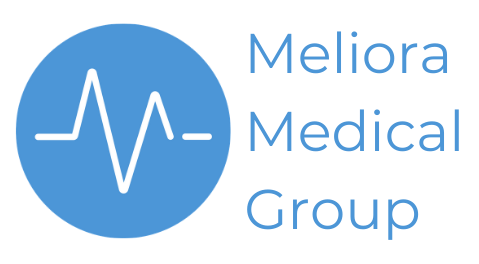What is Concussion?
Use the links below to find out everything you need to know about the injury.
The Key Facts
- Concussion is a brain injury that can occur both in and out of sport
- We all have an important role to play in the recognition and management of concussion
- Returning to normal life (and work/school) should take priority of returning to sport
- Most concussions recover well with time
- There are risks. These are significantly reduced if the brain is allowed to recover before being put at risk of further injury – “If in doubt, sit them out”
- There are Return to Sport protocols to help safely manage a return to sporting activity. These were updated in April 2023 following the release of UK government guidance (see here). Timeframes listed are the earliest allowed, progress should be dependent on symptoms and medical clearance.
Please note that the pathway patients using our Head Injury & Concussion Care service follow goes above and beyond the government guidance. This pathway is shown below.
R2P return to activity & sport pathway – Sept 2023

What is Concussion?
Knowledge around concussion, how it should be managed and the potential short and long-term health implications have advanced hugely in recent years. The term “concussion”, while useful, is imprecise and there remains disagreement around the definition of the injury and the process going on within the brain.What we know about concussion:
- It is a traumatic brain injury
- It can be caused by a direct head blow but also from forces transmitted to the head – eg a whiplash/violent shaking injury
- It can cause a wide range of signs and symptoms
- The effects tend to be short-lived
Signs and Symptoms of Concussion
There are many signs and symptoms that may suggest a concussion has occurred. There is no single definitive list of signs or symptoms that prove a concussion has happened. There may only be one symptom present, or there may be multiple signs and symptoms.Whats are the signs of concussion?
If any of the following signs are noted the injured person should be suspected of having sustained a concussion:
- Dazed, blank or vacant look
- Lying motionless on ground or slow to get up
- Unsteady on feet/falling over/incoordination
- Inappropriate or unusual behaviour
- Loss of consciousness or not responsive
- Grabbing / clutching of head
- Seizure (fits)
Important note: The vast majority of concussions do not have a loss of consciousness (being knocked out). It occurs in less than 10% of injuries and is not required to diagnose concussion.
What are the Symptoms of Concussion?
If any of the following symptoms are experienced the injured person should be suspected of having sustained a concussion:
- Headache
- Dizziness
- Confusion, or feeling “slow”
- Visual problems
- Nausea or vomiting
- Fatigue
- Drowsiness / feeling like “in a fog“ /difficulty concentrating
- “Pressure in head”
- Sensitivity to light or noise
Often children find it difficult to express exactly how they feel. It is common for them to say “I just don’t feel right”.
Worrying symptoms – the “Red Flags”
If any of the following signs or symptoms are noted then the injured person should be transferred to the nearest hospital for urgent medical assessment.
- Severe neck pain
- Double vision
- Weakness or tingling / burning in arms or legs
- Severe or increasing headache
- Seizure (fit)
- Loss of or deteriorating consciousness (increasingly drowsy)
- Repeated vomiting
- Increasing confusion or irritability
- Unusual behaviour change
Immediate Management
If playing sport, the player should be removed from play immediately and take no further part in the activity.
Both sporting and non-sporting concussions need rest.The injured person should be monitored in a quiet, warm environment to ensure no worrying symptoms develop. It is recommended that anyone suspected of sustaining a concussion should be reviewed by a healthcare professional, even if symptoms have gone.
Important note: It is common for the injured person to feel much better quickly. This does not mean they have recovered so, if playing sport, they should not return to play.
Ongoing Management
The initial focus should be on return to normal life – and for children, return to learning – before a return to sport.
1. Rest
Early rest is key to good recovery from concussion. The injured person should be advised to take it easy for a couple of days and have a day or two off school if feeling unwell. Its sensible to minimise screen time and reading during this stage.
2. Return to normal life
If symptom free after a day or two of rest, the focus can change to returning to activities of normal life. This should be done gradually, only moving onto the next phase if remaining symptom free.
An example of a phased “Return to normal life” might be:
Phase 1: Rest
Phase 2: “Working from home” – homework, reading etc
Phase 3: “Part-time study” – half days, avoiding complicated study
Phase 4: “Full return to academic work”
Important note: Return to Learn – Sometimes, the only symptom of concussion that persists is difficulty concentrating in the classroom. Often children don’t realise this is caused by their concussion and it goes unnoticed, persists and results in poor recovery and poor academic performance.Teachers have an important part to play in recognising if a child is under-performing following a concussion so it is sensible to let them know the injury has occurred
Please find our information sheet on returning to school after a concussion here
Return to Sport
Latest research has shown that there are benefits from returning to some physical exercise during the first weeks of recovery. Obviously exercise also has wider physical and mental health benefits.
There can be a gradual return to low risk physical exercise from 1 week post-injury as long as the injured person is managing with day-to-day activities (i.e school/work) without exacerbation of symptoms. The focus should be on maintaining fitness – running, stationary bike, swimming etc. They should not be taking part in formal training activities or competition. For example while running for fitness maintenance would be allowed, they shouldn’t be taking part in athletics training or competitions.
Return to sport
As long as they are symptom-free and have fully returned to normal life and light exercise, a return to sport can start after 14 days. Return to sport should follows a phased process, gradually increasing the amount and intensity of activity. Activities with a risk of contact should be the final stage of a return. Medical assessments are required prior to returning to sports training and then at the end of the graduated return-to-play period, before a player can be cleared as safe to return to sport.
An example of a phased (or graduated) return to sport:
Phase 1: The 7 day rest period.
Phase 2: Light, “low-risk” exercise eg walking, light jog, cycle
Medical Assessment for clearance to return to training (circa day 14)
Phase 3: Sport-specific exercise eg running drills
Phase 4: Non-contact training eg more complex training with increased intensity
Phase 5: Unrestricted training activity
Medical Assessment for clearance to return to competition
Phase 6: Return to play
The earliest return to competitive/match play is day 21 post-injury and only if symptom free at rest for at least 14 days AND have completed Phase 3-5 without recurrence in symptoms.
.
Risks following a concussion
All concussions have the potential to be serious. While the vast majority recover without any long-term implications, risks are significantly increased if further injury is sustained when the brain has not had time to recover.
If concussions are not managed properly there are the following health risks:
- Prolonged symptoms – sometimes referred to as post-concussion syndrome
- Long term health issues – concerns around neuro-degenerative problems (there remains some controversy around this)
- Death – an extremely rare complication called “Second Impact Syndrome”
This is why recognition and immediate removal from play during sport is so important. The risks of these complications far outweigh the benefits of allowing a player to continue “If in doubt, set them out”.
Medical Assessment
Ideally all concussions should be looked after by a doctor experienced in the management of the injury. This not only ensures that the right advice is given but it has also been shown to improve recovery.
Medical assessment with a doctor is recommended at the following timepoints:
- As soon as possible after the initial injury
- Before starting the graduated return to play (GRTP) process (circa day 14)
- Before return to full sporting activity
- If there are any concerns about recovery
